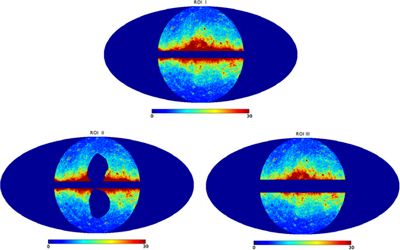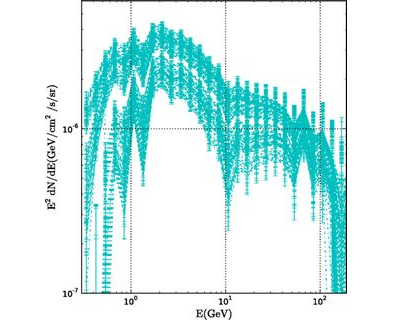Interestingly, dark matter accounts for 27% of the mass/energy of the universe. However, we know nothing about it except its gravitational effect. Dark matter particles may interact with themselves or standard model particles via weak or other new physical interaction, and then produce standard model particles, by which way it is called indirect dark matter search.
The detection of dark matter particles is a very active field. The most attracting signal recently is the GeV excess of galactic center, as it may well indicate the dark matter origin. Nevertheless, due to the significant uncertainty in the foreground of this signal (i.e. galactic diffuse gamma ray radiation), many scholars doubt the authenticity of this signal.
The scholars at the Key Laboratory of Dark Matter and Space Astronomy, Purple Mountain Observatory studied the variation, especially the authenticity, of GeV excess in different diffuse Galactic gamma ray emission (DGE) templates, by analyzing the data of Fermi-LAT. They also studied its spectrum energy distribution and constrain the property of dark matter. For such a purpose, they adopted in total 128 background templates used in the study of the Fermi-LAT observations of the diffuse gamma ray emission considering the effects of cosmic rays and the interstellar medium. The possible GeV excess has been analyzed in three regions of interest. The introduction of such an additional component centered at the Galactic center is found to have improved the goodness of fit to the data significantly in all background template models regardless of whether the excess spectrum is fixed or not. Their results thus suggest that the presence of a statistically significant GeV excess in the inner Galaxy is robust thought its spectrum depends on the DGE model adopted in the analysis.

Figure 1.The regions of interest are chosen to minimize the uncertainties from background modeling. What is shown here are the count maps of gamma rays in the energy range of 300 MeV–300 GeV. In the top panel (i.e., ROI I), we mask |b|<5° to reduce the contamination from known underpredicted gamma-ray emission above a few GeV in the galactic plane [31] and also to avoid analyzing the complex Galactic center. We also mask |l|>80° to minimize the effect of the outer Galaxy region which dominates in an all sky likelihood ratio test but will not considerably contribute to the dark-matter annihilation signal [31]. In the bottom-left panel (i.e., ROI II), the Fermi bubbles are further masked to minimize its possible degeneracy with a dark-matter signal in the low latitude region. In the bottom-right panel, we mask the regions of |b|<10°and |l|>80° (i.e., ROI III) to minimize the contamination of the possibly misleading GeV emission, which would be less extended, from millisecond pulsars, pulsars, SNRs, bremsstrahlung, or neutral pion decay.

Figure 2. The spectrum energy distribution of the GeV excess, averaged within 10° of the Galactic center and assuming a generalized NFW profile with an inner slope γ ¼ 1.2, for all 128 of the DGE models. Note that the fits are preformed in ROI I. The excess peaking in the energy range of 1–3 GeV is distinct in all of the fits.
This work by Bei Zhou, Yunfeng Liang, Xiaoyuan Huang, Xiang Li, Yizhong Fan, Lei Feng and Jin Chang has been published in the Physical Review D. Please see PRD 91, 123010 (2015) , for more details:
(http://journals.aps.org/prd/abstract/10.1103/PhysRevD.91.123010)
(Information Source: Purple Mountain Observatory, CAS)

